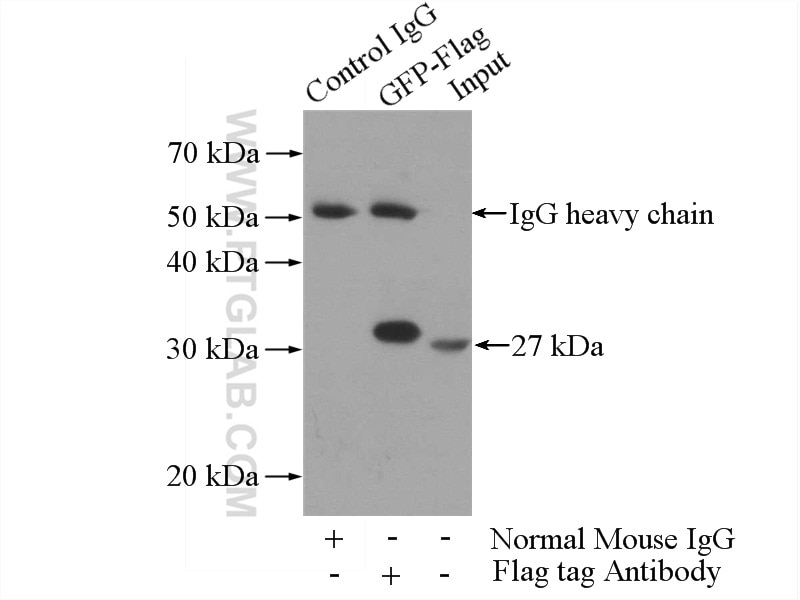DDDDK tag Monoklonaler Antikörper
DDDDK tag Monoklonal Antikörper für WB, IP, ELISA
Wirt / Isotyp
Maus / IgG2b
Getestete Reaktivität
rekombinanten Protein
Anwendung
WB, IP, ELISA
Konjugation
Unkonjugiert
CloneNo.
1C1D2
Kat-Nr. : 60002-1-Ig
Synonyme
"DDDDK tag Antibodies" Comparison
View side-by-side comparison of DDDDK tag antibodies from other vendors to find the one that best suits your research needs.
Geprüfte Anwendungen
| Erfolgreiche Detektion in WB | Recombinant Protein |
| Erfolgreiche IP | Rekombinantes Protein Protein |
Empfohlene Verdünnung
| Anwendung | Verdünnung |
|---|---|
| Western Blot (WB) | WB : 1:2000-1:16000 |
| Immunpräzipitation (IP) | IP : 0.5-4.0 ug for 1.0-3.0 mg of total protein lysate |
| It is recommended that this reagent should be titrated in each testing system to obtain optimal results. | |
| Sample-dependent, check data in validation data gallery | |
Veröffentlichte Anwendungen
| WB | See 9 publications below |
| IP | See 3 publications below |
Produktinformation
60002-1-Ig bindet in WB, IP, ELISA DDDDK tag und zeigt Reaktivität mit rekombinanten Protein
| Getestete Reaktivität | rekombinanten Protein |
| Wirt / Isotyp | Maus / IgG2b |
| Klonalität | Monoklonal |
| Typ | Antikörper |
| Immunogen | Peptid |
| Vollständiger Name | DDDDK tag |
| Gene symbol | |
| Gene ID (NCBI) | |
| Konjugation | Unkonjugiert |
| Form | Liquid |
| Reinigungsmethode | Antigen-Affinitätsreinigung |
| Lagerungspuffer | PBS with 0.02% sodium azide and 50% glycerol |
| Lagerungsbedingungen | Bei -20°C lagern. Nach dem Versand ein Jahr lang stabil Aliquotieren ist bei -20oC Lagerung nicht notwendig. 20ul Größen enthalten 0,1% BSA. |
Hintergrundinformationen
Protein tags are protein or peptide sequences located either on the C- or N- terminal of the target protein, which facilitates one or several of the following characteristics: solubility, detection, purification, localization and expression. The DYKDDDDK(FLAG) peptide has been used extensively as a general tag in expression vectors. This peptide can be expressed and detected with the protein of interest as an amino-terminal or carboxy-terminal fusion. N-terminal DDDDK vectors provide an Ek cleavage site for removal of the fusion tag. The DDDDK peptide is likely to be located on the surface of a fusion protein because of its hydrophilic nature. As a result, the DDDDK peptide is more likely to be accessible to antibodies. A DDDDK-tag can be used in many different assays that require recognition by an antibody, such as western blotting, immunocytochemistry, immunoprecipitation, flow cytometry, protein purification, and in the study of protein-protein interactions, cell ultrastructure, and protein localization and so on. This antibody is a mouse monoclonal antibody raised against 3xFlag (3xDYKDDDDKT) sequence and recognizes the (3x)DYKDDDDK peptide and detects DDDDK-tagged proteins.
Protokolle
| PRODUKTSPEZIFISCHE PROTOKOLLE | |
|---|---|
| IP protocol for DDDDK tag antibody 60002-1-Ig | Protokoll herunterladen |
| STANDARD-PROTOKOLLE | |
|---|---|
| Klicken Sie hier, um unsere Standardprotokolle anzuzeigen |
Publikationen
| Species | Application | Title |
|---|---|---|
Autophagy Tumor-derived lactate promotes resistance to bevacizumab treatment by facilitating autophagy enhancer protein RUBCNL expression through histone H3 lysine 18 lactylation (H3K18la) in colorectal cancer | ||
Oncogene TRIB3 confers radiotherapy resistance in esophageal squamous cell carcinoma by stabilizing TAZ. | ||
Aging (Albany NY) HOXB9 enhances the ability of lung cancer cells to penetrate the blood-brain barrier. | ||
Sci Rep TDP-43 aggregation mirrors TDP-43 knockdown, affecting the expression levels of a common set of proteins. | ||
J Virol Enterovirus D68 Protease 2Apro Targets TRAF3 to Subvert Host Innate Immune Responses. | ||


